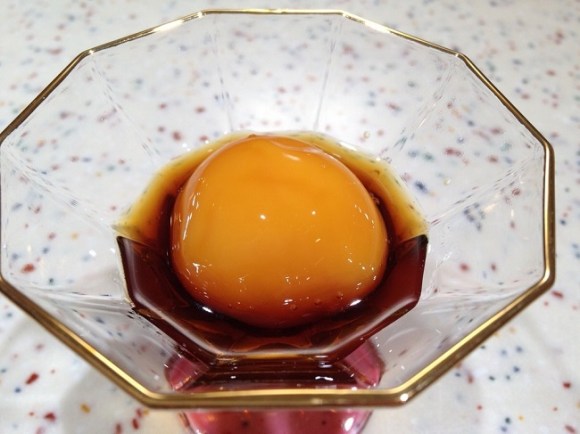
Japan seems like a heaven for lovers of raw food–you can even get raw horse meat, if you’re so inclined. Coming from the midwest of the US, I am seriously disinclined to touch any meat that’s not cooked well-done, especially if it comes from a formerly feathered friend. The very concept of “raw egg” is intrinsically linked to “death by salmonella” in my mind, despite the fact that raw egg dishes have been popular in Japan since long before I was born.
But knowing something logically and accepting it emotionally are two very different things. So, while I’m reluctant to try it, I’m that sure raw, frozen egg dishes are actually exceptionally tasty.
So, if you are interested in trying it, here’s some information on the dish and how to make it yourself.
Apparently raw, frozen eggs have become popular on the Japanese website Cookpad (English version here), a recipe-sharing site which boasts over 1,850,000 recipes. While not all of them are necessarily great, there’s probably more than a few excellent recipes if you’re looking for something good to cook.
And one of the bigger trends on Cookpad right now is raw, frozen egg dishes. While the very thought of it makes my stomach do backflips, it’s apparently a delicious way to enjoy your eggs–and easy to prepare as well! Raw egg dishes in Japan, like sukiyaki, usually involve unfrozen eggs, so it’s definitely a unique take on eggs. It does seem a bit more sanitary as well.
We should note that, at least in the recipes we’ve looked at, the eggs aren’t actually completely frozen when eaten–but they’re not entirely thawed either. However, “raw, almost-but-not-entirely-frozen eggs” would be a bit cumbersome, so I’ll just stick with “frozen!”
Now, let’s take a look at one of the most basic recipe for frozen eggs on Cookpad. You can even try it at home if you want, but we are absolutely not in any way responsible if you get sick!
First, the ingredients for two people are: Two eggs, a tablespoon of dashi shoyu (a mixture of stock and soy sauce that you can make yourself), and a tablespoon of shaoxing wine (which can be replaced with nihonshu if you prefer).
The steps involved are pretty easy too! First, take your two eggs, put them in a ziploc bag (since the shells will crack), and leave them in the freezer overnight. Once your eggs are thoroughly frozen, take them out and let them thaw for three hours at room temperature. They won’t be entirely thaw at this point, but they should be “mochipuri,” as described by the recipe, which is an onomatopoeia that roughly means “chewy and kind of firm.”
Next, separate the egg white from egg yolk, putting the latter into a dish with the dashi shoyu and shaoxing wine/nihonshu. Wrap the dish and let it sit for 15 minutes, being sure to flip the eggs half way through so that they soak up the sauce on both sides. Once time is up, you’re done and it’s time to eat! Just place the eggs in shallow dishes with a bit of the mixture and eat in small bites with chopsticks, spoons, or whatever utensil you prefer!
▼Putting the egg yolks in the mixture of dashi shoyu and wine.
▼Just waiting for 15 minutes
▼Itadakimasu!
The recipe also recommends adding some squid sashimi or sweet shrimp (ama-ebi) on top, if you’re feeling adventurous.
▼Well, I’ll say this. It does look good!
And there are a lot more uses for frozen eggs and frozen egg yolks, like using them as furikake for your rice!
Of course, even though these are (somewhat) frozen eggs, you should still use caution since they’re definitely raw and uncooked. Be sure to get fresh eggs from a trusted source! And let us know if you try this or any other frozen egg recipes. If you happen have your own version, be sure to share with everyone in the comments, too!
Sources: Cookpad (Ogunyanko), Huffington Post Japan
Images: Cookpad (Ogunyanko)

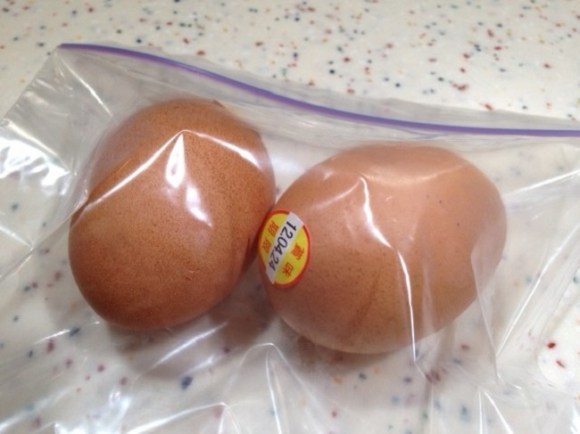
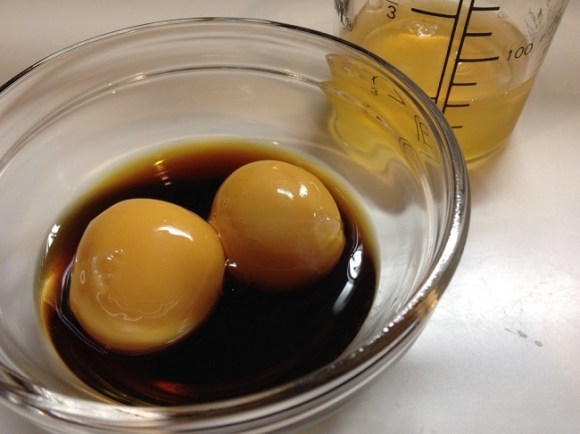
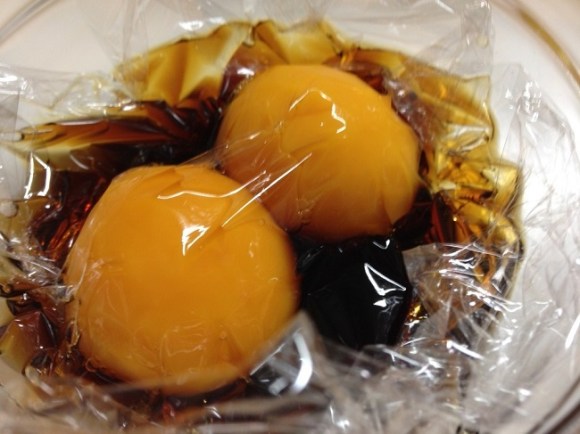
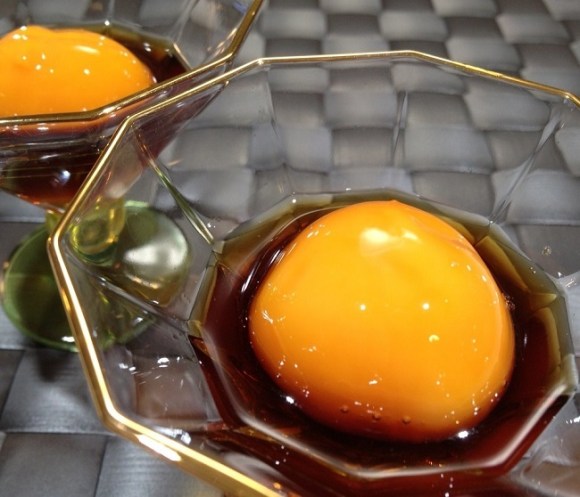
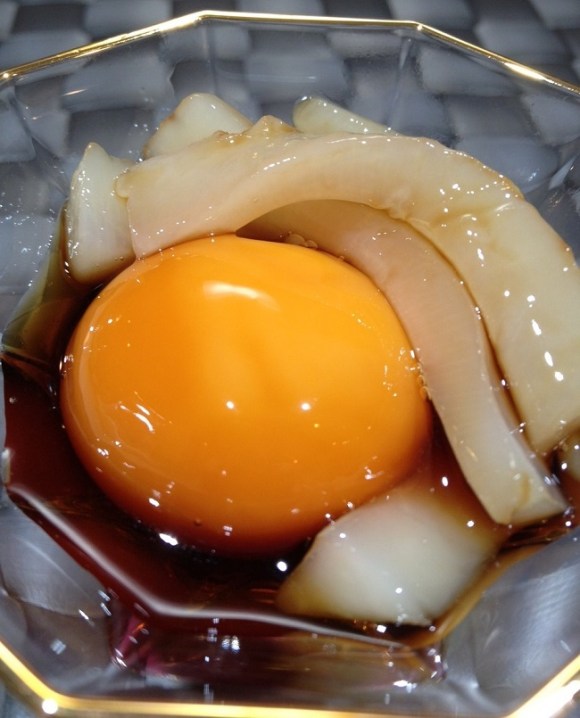
 We brave the should-be-abomination of raw egg and coffee, is it a taste sensation? 【Taste Test】
We brave the should-be-abomination of raw egg and coffee, is it a taste sensation? 【Taste Test】 Japanese marshmallow omelette: A real thing you can (and should) make right away 【Rocket Kitchen】
Japanese marshmallow omelette: A real thing you can (and should) make right away 【Rocket Kitchen】 How to make Tokyo Disneyland’s awesome Mickey Mouse eggs at home!【SoraKitchen】
How to make Tokyo Disneyland’s awesome Mickey Mouse eggs at home!【SoraKitchen】 Wow Guests at Your Next Party with 50 Egg Yolks Straight from the Rice Cooker
Wow Guests at Your Next Party with 50 Egg Yolks Straight from the Rice Cooker Japan goes crazy for “gaming eggs,” and here’s the super-easy recipe【SoraKitchen】
Japan goes crazy for “gaming eggs,” and here’s the super-easy recipe【SoraKitchen】 Pizza Hut Japan’s hot lucky bags are perfect for a New Year’s pizza party
Pizza Hut Japan’s hot lucky bags are perfect for a New Year’s pizza party We found possibly the quietest Japanese-style hotel in Tokyo’s bustling Shinjuku district
We found possibly the quietest Japanese-style hotel in Tokyo’s bustling Shinjuku district Get in the Gundam robot! Event lets fans sit in giant Zeta Gundam replica cockpit
Get in the Gundam robot! Event lets fans sit in giant Zeta Gundam replica cockpit Standing sleeping pods coming to Tokyo cafe, promise to relieve fatigue and stress【Pics】
Standing sleeping pods coming to Tokyo cafe, promise to relieve fatigue and stress【Pics】 Tokyu Kabukicho Tower backtracks on its gender-neutral toilets, rejigging them to appease public
Tokyu Kabukicho Tower backtracks on its gender-neutral toilets, rejigging them to appease public Japanese artists anthropomorphise national flags into samurai characters for 2020 Tokyo Olympics
Japanese artists anthropomorphise national flags into samurai characters for 2020 Tokyo Olympics Rage against the smoothie machine with this 7-Eleven drink hack【Taste test】
Rage against the smoothie machine with this 7-Eleven drink hack【Taste test】 7-Eleven Japan’s ramen-cooking robot whipped us up a bowl of noodles【Taste test】
7-Eleven Japan’s ramen-cooking robot whipped us up a bowl of noodles【Taste test】 Japanese chain Bikkuri Donkey’s enormous salad almost beats Mr. Sato, but not because of its size
Japanese chain Bikkuri Donkey’s enormous salad almost beats Mr. Sato, but not because of its size Dragon Quest Burgers and Slime drinks are coming to McDonald’s Japan【Video】
Dragon Quest Burgers and Slime drinks are coming to McDonald’s Japan【Video】 Starbucks Japan ready to get Year of the Horse started with adorable drinkware and plushies【Pics】
Starbucks Japan ready to get Year of the Horse started with adorable drinkware and plushies【Pics】 Lacquerware supplier to emperor of Japan and Pokémon team up for new tableware
Lacquerware supplier to emperor of Japan and Pokémon team up for new tableware Cyberpunk anime meets traditional culture in Ghost in the Shell gold leaf Japanese changing screens
Cyberpunk anime meets traditional culture in Ghost in the Shell gold leaf Japanese changing screens 7 great places to see Mt. Fuji from without having to climb it
7 great places to see Mt. Fuji from without having to climb it Japan may add Japanese language proficiency, lifestyle classes to permanent foreign resident requirements
Japan may add Japanese language proficiency, lifestyle classes to permanent foreign resident requirements Hello Kitty Choco Egg figures are an adorable trip through three periods of Japanese pop culture【Pics】
Hello Kitty Choco Egg figures are an adorable trip through three periods of Japanese pop culture【Pics】 Japan’s otoshidama tradition of giving kids money at New Year’s gets a social welfare upgrade
Japan’s otoshidama tradition of giving kids money at New Year’s gets a social welfare upgrade Starbucks Japan releases new zodiac chilled cup drink for 2026
Starbucks Japan releases new zodiac chilled cup drink for 2026 Can a dirty butthole make you filthy rich in Japan? We’re starting a New Year’s lottery experiment
Can a dirty butthole make you filthy rich in Japan? We’re starting a New Year’s lottery experiment 7-Eleven Japan starts new temporary luggage storage service in over 300 branches
7-Eleven Japan starts new temporary luggage storage service in over 300 branches Disillusionment at Tsukiji’s tourist-target prices led us to a great ramen restaurant in Tokyo
Disillusionment at Tsukiji’s tourist-target prices led us to a great ramen restaurant in Tokyo Starbucks teams up with 166-year-old Kyoto doll maker for Year of the Horse decorations【Photos】
Starbucks teams up with 166-year-old Kyoto doll maker for Year of the Horse decorations【Photos】 Tokyo considering law requiring more trash cans following litter increase in heavily touristed area
Tokyo considering law requiring more trash cans following litter increase in heavily touristed area Tokyo’s Tsukiji sushi neighborhood asks tour groups to stay away for the rest of the month
Tokyo’s Tsukiji sushi neighborhood asks tour groups to stay away for the rest of the month Nintendo’s Kirby now delivering orders at Kura Sushi restaurants, but not in Japan
Nintendo’s Kirby now delivering orders at Kura Sushi restaurants, but not in Japan Tokyo event lets you travel back in time, for free, to celebrate 100 years since Showa era start
Tokyo event lets you travel back in time, for free, to celebrate 100 years since Showa era start Sanrio theme park in Japan announces plans to expand into a Sanrio resort
Sanrio theme park in Japan announces plans to expand into a Sanrio resort Stamina-destroying “Paralysis Noodles” are Tokyo’s newest over-the-top ramen innovation
Stamina-destroying “Paralysis Noodles” are Tokyo’s newest over-the-top ramen innovation Survey asks foreign tourists what bothered them in Japan, more than half gave same answer
Survey asks foreign tourists what bothered them in Japan, more than half gave same answer Japan’s human washing machines will go on sale to general public, demos to be held in Tokyo
Japan’s human washing machines will go on sale to general public, demos to be held in Tokyo Japan’s deadliest food claims more victims, but why do people keep eating it for New Year’s?
Japan’s deadliest food claims more victims, but why do people keep eating it for New Year’s? We deeply regret going into this tunnel on our walk in the mountains of Japan
We deeply regret going into this tunnel on our walk in the mountains of Japan Studio Ghibli releases Kodama forest spirits from Princess Mononoke to light up your home
Studio Ghibli releases Kodama forest spirits from Princess Mononoke to light up your home Major Japanese hotel chain says reservations via overseas booking sites may not be valid
Major Japanese hotel chain says reservations via overseas booking sites may not be valid Put sesame oil in your coffee? Japanese maker says it’s the best way to start your day【Taste test】
Put sesame oil in your coffee? Japanese maker says it’s the best way to start your day【Taste test】 No more using real katana for tourism activities, Japan’s National Police Agency says
No more using real katana for tourism activities, Japan’s National Police Agency says Starbucks Japan reveals new sakura drinkware collection, inspired by evening cherry blossoms
Starbucks Japan reveals new sakura drinkware collection, inspired by evening cherry blossoms Updated cherry blossom forecast shows extra-long sakura season for Japan this year
Updated cherry blossom forecast shows extra-long sakura season for Japan this year Raw eggs may lead to heads as bald as eggs
Raw eggs may lead to heads as bald as eggs It doesn’t get any fresher than raw-egg pudding!【SoraKitchen】
It doesn’t get any fresher than raw-egg pudding!【SoraKitchen】 Imitation octopus balls are Japan’s newest pseudo-gourmet recipe for boiled eggs【Recipe】
Imitation octopus balls are Japan’s newest pseudo-gourmet recipe for boiled eggs【Recipe】 We found the prettiest TKG ever at a restaurant specializing in raw eggs on rice in Tokyo
We found the prettiest TKG ever at a restaurant specializing in raw eggs on rice in Tokyo Latest unbelievable chip flavour in Japan captures the runny egg flavour of onsen tamago
Latest unbelievable chip flavour in Japan captures the runny egg flavour of onsen tamago Edo-era recipes are published online, give us a chance to try Japanese foods from centuries past
Edo-era recipes are published online, give us a chance to try Japanese foods from centuries past What’s the most popular way to prepare Japan’s beloved breakfast dish, Tamago Kake Gohan?
What’s the most popular way to prepare Japan’s beloved breakfast dish, Tamago Kake Gohan? We bring you three more traditional Japanese recipes from centuries past
We bring you three more traditional Japanese recipes from centuries past The internet’s latest culinary masterpiece: Cup Noodle Steamed Egg【Taste Test】
The internet’s latest culinary masterpiece: Cup Noodle Steamed Egg【Taste Test】 7-Eleven Japan’s egg broth and rice may be the dream combination we’ve been missing【SoraKitchen】
7-Eleven Japan’s egg broth and rice may be the dream combination we’ve been missing【SoraKitchen】 We try all-you-can-eat raw eggs for 730 yen, turns out to be way better than it sounds
We try all-you-can-eat raw eggs for 730 yen, turns out to be way better than it sounds Japanese cook shocks Internet with yolkless egg discovery
Japanese cook shocks Internet with yolkless egg discovery Olaf from Disney’s Frozen is cute enough to eat!
Olaf from Disney’s Frozen is cute enough to eat! Japan has eggs that smell and taste like yuzu citrus fruit, and they’re amazing!
Japan has eggs that smell and taste like yuzu citrus fruit, and they’re amazing! New contraption from Japan lets you cook paper-thin egg omelets in your microwave
New contraption from Japan lets you cook paper-thin egg omelets in your microwave
Leave a Reply